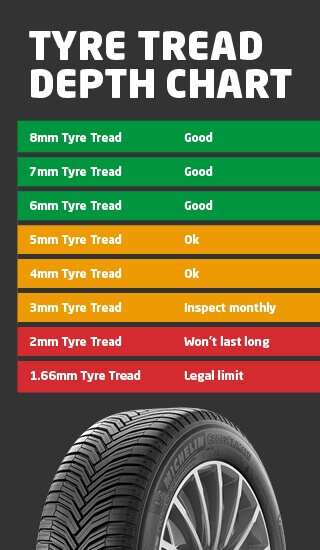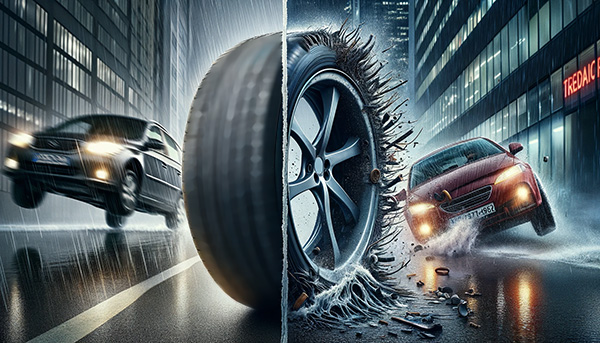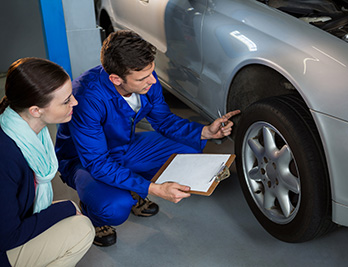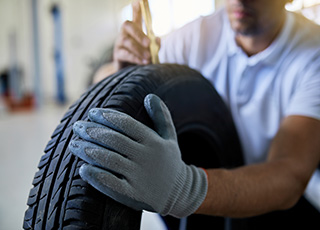Your car’s tyres connect you to the road. They’re the only point of contact between your vehicle and the tarmac, playing a crucial role in steering, braking, and overall handling. For optimal safety on the road, ensuring your tyres are in good condition is paramount.
This article delves into the importance of regular tyre checks, explaining how to ensure your tyres meet legal requirements and maximise safety.
The Legal Minimum Tread Depth: Staying Within the Guidelines
 In the UK, the legal minimum tread depth for car tyres is 1.6mm across the central three-quarters of the tyre. This measurement applies to both summer and winter tyres. It’s crucial that the tread depth meets this requirement across the entire circumference of the tyre, not just in isolated sections.
In the UK, the legal minimum tread depth for car tyres is 1.6mm across the central three-quarters of the tyre. This measurement applies to both summer and winter tyres. It’s crucial that the tread depth meets this requirement across the entire circumference of the tyre, not just in isolated sections.
Unfortunately, worn tyres are a common culprit behind MOT failures. By incorporating regular tyre checks into your routine, you can avoid unnecessary hassle and ensure your vehicle remains roadworthy.
Beyond the Minimum: Why Deeper Tread Matters
Don’t be lulled into a false sense of security by the legal minimum tread depth of 1.6mm. While it ensures your tyres are technically road-legal, tyre safety experts recommend a more cautious approach. Many advise replacing your tyres when the tread reaches 3mm.
There’s a compelling reason for this recommendation. Tests conducted by MIRA, a leading UK technical organisation, revealed a worrying trend: stopping distances increase significantly once tyres fall below the 3mm threshold. The difference can be staggering – a tyre with 3mm tread depth can take up to 44% longer to come to a complete stop in wet conditions compared to a tyre with 1.6mm.
This dramatic increase in stopping distance highlights the critical role of tread depth in maintaining control and safety on the road, especially during unpredictable weather conditions. By prioritising deeper tread depth, you’re essentially buying yourself valuable extra stopping power when you need it most.
Understanding the Role of Tread Depth in Wet Conditions
When the heavens open and rain transforms the road into a glistening surface, worn tyres become a significant safety concern. The key player in maintaining grip and control during wet weather conditions is your tyre’s tread depth. This intricate network of grooves isn’t just for aesthetics; it’s a carefully designed water management system.
Imagine your tyres carving through a thin film of water on the road. The tread channels act like miniature aqueducts, efficiently dispersing water away from the contact patch – the crucial area where the tyre meets the road surface. This ensures optimal grip, allowing you to steer and brake predictably.

Here’s where tread depth becomes critical. Deeper treads offer more channels and greater volume capacity, allowing them to handle this deluge more effectively. Shallower treads, nearing the legal minimum, become overwhelmed, leading to water accumulating between the tyre and the road. This creates a dangerous phenomenon known as aquaplaning.
In essence, aquaplaning occurs when a layer of water separates the tyre from the road surface, causing it to lose traction and essentially skim across the water. The vehicle becomes unresponsive to steering and braking, posing a significant risk to both driver and passengers.
By prioritising deeper tread depth, you equip your tyres with the ability to handle heavy rain more effectively. This translates to better grip, shorter stopping distances, and ultimately, enhanced safety on the road whenever the weather takes a turn for the worse.
Checking Your Tyre Tread Depth: Three Simple Methods
There are three primary methods for checking your car’s tyre tread depth:
The 20p Test: This quick and easy method utilises a standard 20p coin. Simply insert the coin into the tread grooves of your tyre. If the outer band on the coin remains hidden, your tyres are above the legal limit. However, if the outer band is visible, your tyres may be unsafe and require inspection by a qualified mechanic. For optimal safety, it’s recommended to conduct the 20p test every two weeks, especially before embarking on long journeys.
Tyre Tread Wear Indicators: Some tyres incorporate wear indicators moulded into the sidewall. These indicators typically resemble a line or arrow positioned below the outer tread. If the surface of the tyre is flush with these indicators, the tread depth has fallen below the legal limit, and tyre replacement is necessary.
Tyre Tread Depth Gauge: For a more precise measurement, consider purchasing a tyre tread depth gauge. These tools provide an accurate reading of the remaining tread depth, allowing you to make informed decisions about tyre replacement. Alternatively, some retailers offer colour-coded tyre tread depth checkers that provide a quick visual indicator of your tyre’s legality.
The Risks of Driving with Illegal or Bald Tyres
Cruising down the road on tyres worn beyond the legal limit is a recipe for disaster. Not only are you compromising your own safety and that of others, but you’re also inviting hefty fines and potential insurance headaches.
Imagine this: you’re navigating a busy intersection when a sudden downpour reduces visibility. With worn tyres, your ability to brake effectively diminishes dramatically. This scenario highlights the primary risk – a significant increase in stopping distances, potentially leading to an accident. It’s a gamble no driver should take.
The consequences extend beyond the immediate danger. Should you be involved in an accident while driving on illegal tyres, your insurance company might have grounds to invalidate your claim. This means you’d be left footing the bill for repairs to your own vehicle, adding insult to injury.
 The financial penalties can be equally punitive. Driving on a single illegal tyre can result in a fine of up to £2,500. With four bald tyres, the potential penalty could reach a staggering £10,000, accompanied by a whopping 12 penalty points on your driving licence. In the worst-case scenario, this could lead to a disqualification.
The financial penalties can be equally punitive. Driving on a single illegal tyre can result in a fine of up to £2,500. With four bald tyres, the potential penalty could reach a staggering £10,000, accompanied by a whopping 12 penalty points on your driving licence. In the worst-case scenario, this could lead to a disqualification.
Taking a few minutes to check your tyre tread depth is a simple yet crucial safety measure. It’s an investment that pays off in peace of mind, safer journeys, and potential cost savings. Remember, the road is a shared space – prioritise safety for yourself and everyone around you by ensuring your tyres are legal and roadworthy.
By prioritising regular tyre checks and ensuring your tyres meet the legal minimum tread depth, you’re not just complying with the law – you’re actively taking steps to safeguard yourself and your fellow road users. Remember, a few minutes spent checking your tyres can make a world of difference on the road.



Recent Comments